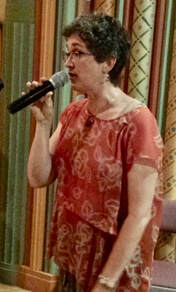I love dancing like I love my life. I love music, too – but that’s my career. Dance has always been what I’ve done for the sheer joy of it. Dance makes me feel alive. When I dance, the world is in total sync. When I dance, I get a huge smile on my face that doesn’t stop until I do.
I first learned the joy of dance as a toddler, standing on my grandfather’s feet in front of the television, doing the box step to Lawrence Welk. I loved studying ballet – I took classes until I was 12, just at the time I’d be going on point, when class hours and demands went way up. My parents made me choose between dance and music lessons. They might as well have asked me to cut off one of my arms. After a lot of tears and sleepless nights I chose music. A career in music was predictable, inevitable. I told myself I didn’t have what it took for a career in dance.
Dance continued as a hobby in every form I could find – Swing, Lindy, International, Modern. In graduate school I learned about play-parties, which were essentially square dance moves done to singing instead of instruments. I happily discovered that this kind of dance would become a regular part of my folk-based music classes. Interviewing for my music teaching job in Baltimore, the school chaplain asked me if I’d heard of Morris, Contra, or English Country Dance. When I got one out of 3, he said “Take this job and stick with me.” I did. A lifetime of joy in traditional dance and music was born.
In my twenties, I made a firm decision to never let anyone in the traditional dance world know I played the piano. I didn’t want to be on stage, I wanted to dance. In the early days, I was out dancing 3-4 nights a week in my regional area. I met my first husband at a contradance.
I was also doing Morris, an English ritual dance which involves bells, hankies and sticks and waking up the earth for fertility in the spring. We mostly did this outside, often on concrete. There was a lot of leaping in the air and landing hard on one leg. High impact aerobics classes completed my activities.
All in all, I was not particularly nice to my knees. I didn’t care. I was in great shape aerobically, my legs were long and lean, life was good.
Morris and aerobics came to a crashing halt when I got pregnant and started dislocating virtually everything. (Thanks, EDHS.) The ache in my knees from all that jumping came in my thirties, and I never returned to either of those, turning to bicycling instead.
Dance continued as a hobby in every form I could find – Swing, Lindy, International, Modern. In graduate school I learned about play-parties, which were essentially square dance moves done to singing instead of instruments. I happily discovered that this kind of dance would become a regular part of my folk-based music classes. Interviewing for my music teaching job in Baltimore, the school chaplain asked me if I’d heard of Morris, Contra, or English Country Dance. When I got one out of 3, he said “Take this job and stick with me.” I did. A lifetime of joy in traditional dance and music was born.
In my twenties, I made a firm decision to never let anyone in the traditional dance world know I played the piano. I didn’t want to be on stage, I wanted to dance. In the early days, I was out dancing 3-4 nights a week in my regional area. I met my first husband at a contradance.
I was also doing Morris, an English ritual dance which involves bells, hankies and sticks and waking up the earth for fertility in the spring. We mostly did this outside, often on concrete. There was a lot of leaping in the air and landing hard on one leg. High impact aerobics classes completed my activities.
All in all, I was not particularly nice to my knees. I didn’t care. I was in great shape aerobically, my legs were long and lean, life was good.
Morris and aerobics came to a crashing halt when I got pregnant and started dislocating virtually everything. (Thanks, EDHS.) The ache in my knees from all that jumping came in my thirties, and I never returned to either of those, turning to bicycling instead.
|
At that point I learned to call contra and square dances, and into my forties and fifties I became in demand as a dance leader, putting me on stage more than I was on the floor. After I met Dave (also at a dance) I gave in and finally started playing piano for dances. Oddly enough, the world of dance slowly evolved into a career after all.
|
I told myself for years that this was ok, that I could give up more and more forms of dance to take care of my knees. It’s not ok. Not at all. I am really looking forward to the end of April, when I can get back on the floor in the gentlest form of dance, English Country. We’re the band for a full weekend, but we’re sharing the stage which means we also get some dance time.
It’s the big test of my new knee. Slow forward - I’m ready for some joy.
It’s the big test of my new knee. Slow forward - I’m ready for some joy.



 RSS Feed
RSS Feed